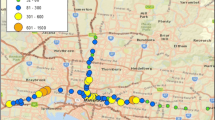Abstract
This paper describes a survey of lead in soil and computer generated maps that have been derived for New Orleans, Louisiana. The soil survey included streetside, houseside and open space samples. Because the survey covered every census tract in the metropolitan area it was possible to construct a computer-generated map of the distribution of lead dust in the soils of the urban environment. The data base consists of coordinates, site characteristics and lead analytical results of 3,704 soil samples. The resulting graphics show peaks of lead ranging from 600–1,200 μg per g in the streetside soil of the inner-city and a steeply declining slope to the suburban areas of the city where the lead content of streetside soils is less than 75 μg/g. In the inner-city, the amount of lead in soils found near building foundations is 10 to 20 times higher than the soils adjacent to streets where the median lead content of soils is over 300 μg g−1. In areas surrounding the city core (“mid-city”), the amount of lead next to the foundation and adjacent to the street are equivalent with medians of 110 μg g−1. In suburban locations, the median lead content of soil along streetsides is 86 μg g−1. Soils adjacent to surburban foundations has a median Pb content of 50 μg g−1. The lowest median lead content in soil is found in open spaces, ranging from 212 to 40 to 28 μg g−1, respectively, for the inner-city, mid-city, and suburbs. These observations are consistent with the production and consumer use of lead-based paint and leaded-fuels within the modern city.
Similar content being viewed by others
References
Angle, C., McIntire, M. and Colucci, A.V. 1975a. Lead in air, dustfall, soil, housedust, milk and water: Correlation with blood lead of urban and suburban school children.Trace Substan. Environ. Health,8, 23–29.
Angle, C., McIntire, M. and Vest, G. 1975b. Blood lead of Omaha school children — Topographical correlation with industry, traffic and housing.Neb. Med. J.,60, 97–102.
Chaney, R. and Mielke, H. 1986. Standards for soil lead limitations in the United States.Trace Substan. Environ. Health,20, 357–377.
Davies, B.E., Conway, D., and Holt, S. 1979. Lead pollution of London soils: a potential restriction of their use for growing vegetables.J. Agricultural Sci. (Cambridge),93, 749–752.
Davies, B.D. and Houghton, N.J. 1984. Distance-decline patterns in heavy metal contamination of soils and plants in Birmingham England.Urban Ecology 8, 285–294.
Earickson, R.J. and Billick, I.H. 1988. The areal association of urban air pollutants and residential characteristics: Louisville and Detroit.Applied Geography,8, 5–23.
Fergusson, J.E., Hayes, R.W., Yong, T.S. and Thiew, S.H. 1980. Heavy metal pollution by traffic in Christchurch, New Zealand. Lead and cadmium content of dust, soil, and plant samples.N.Z. J. Sci.,23, 293–310.
Hunt, A., Johnson, D.L. and Thornton, I. 1991. Descriptive apportionment of lead in housedust by automated SEM.Water, Air and Soil Pollution,57–58, 69–77.
Hunt, A., Johnson, D.L., Watt, J.M. and Thornton, I. 1992. Characterizing the sources of particulate lead in house dust by automated scanning electron microscopy.Env. Sci. Tech.,26, 1513–1523.
Hunt, A., Johnson, D.L., Thornton, I. and Watt, J.M. 1993. Apportioning the sources of lead in house dusts in the London borough of Richmond, England.The Sci. Tot. Env.,138, 138–206.
Linton, R.W., Natusch, D.F.S., Solomon, R.L. and Evans, C.A. Jr. 1980. Physicochemical characterization of lead in urban dusts: A microanalytical approach to lead tracing.Env. Sci. Tech.,14, 154–164.
Mielke, H.W. 1991. Lead in residential soils: Background and preliminary results of New Orleans.Int. J. Water Air Soil Poll.,57–58, 111–119.
Mielke, H.W. 1993. Lead dust contaminated U.S.A. communities: Comparison of Louisiana and Minnesota.Applied Geochemistry, Suppl. Issue No. 2, 257–261.
Mielke, H.W. and Adams, J. 1989.Environmental Lead Risk in the Twin Cities. Center for Urban and Regional Affairs, H H Humphrey Center, University of Minnesota, Minneapolis, Minnesota.
Mielke, H.W., Adams, J.L., Reagan, P.L. and Mielke, Jr., P.W. 1989. Soil-dust lead and childhood lead exposure as a function of city size and community traffic flow: The case for lead abatement in Minnesota.Env. Geochem. and Health,9 (Supplement), 253–271.
Mielke, H.W., Anderson, J., Berry, K., Mielke, Jr., P.W., Chaney, R. and Leech, M. 1983. Lead concentrations in inner-city soils as a factor in the child lead problem.Am. J. Public Health,73(12), 1366–1369.
Mielke, H.W., Blake, B., Burroughs, S. and Hassinger, N. 1984. Urban lead levels in Minneapolis: The case of the Hmong children.Environ. Res.,34, 64–76.
Mielke, H.W., Burroughs, S., Wade, R., Yarrow, T. and Mielke, Jr., P.W. 1984/85. Urban lead in Minnesota: Soil transect results of four cities.Minn. Acad. of Sci.,50(1), 19–24.
Peterson, J.T. 1971. Climate of the City. In: T.R. Detwyler (ed.)Man 's Impact on Environment, pp 131–154. McGraw-Hill Book Company, N.Y..
Rolfe, G.L. and Haney, A. 1975. An ecosystem analysis of environmental contamination by lead. University of Illinois at Urbana-Champaign,Institute for Environmental Studies.
Rosner, D. and Markowitz, G. 1985. A “gift of God”?: The public health controversy over leaded gasoline during the 1920s.Am. J. Public Health,75(4), 344–352.
Shellshear I., Jordon L., Hogan D., Shannon, F., 1975 Environmental lead exposure in Christchurch children: Soil lead as a potential hazard.New Zealand Med. J.,81, 382–386.
Author information
Authors and Affiliations
Rights and permissions
About this article
Cite this article
Mielke, H.W. Lead in New Orleans soils: New images of an urban environment. Environ Geochem Health 16, 123–128 (1994). https://doi.org/10.1007/BF01747908
Accepted:
Issue Date:
DOI: https://doi.org/10.1007/BF01747908




